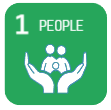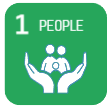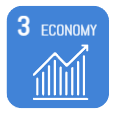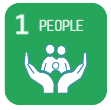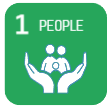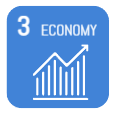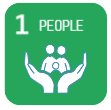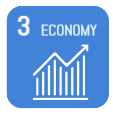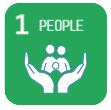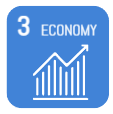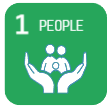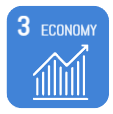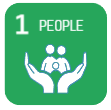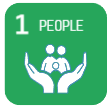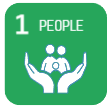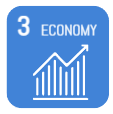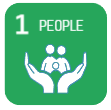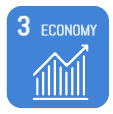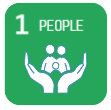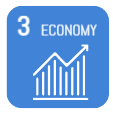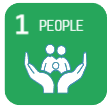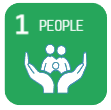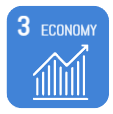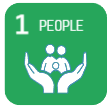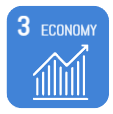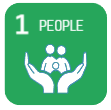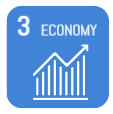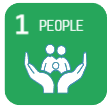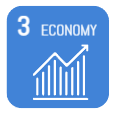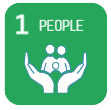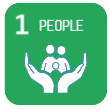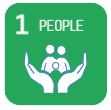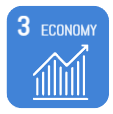4.2.3 - Integrated
|
HLG |
Integrated |
|
|
I1. Limerick City Centre regeneration |
|
|
I2. Disadvantaged urban neighbourhoods |
|
|
I3. Connected city & sub-urban neighbourhoods |
|
|
I4. Town & village renewal & connected settlements |
|
|
I5. Culture, arts, heritage & sport |
|
|
I6. Internationalisation, branding & promotion |
|
|
I7. Innovation & technology application |
|
|
I8. Active travel/sustainable travel |
|
|
I9. Mitigation / climate action / natural resources / biodiversity |
|
|
I10. Green energy /energy systems |
|
Policy Framework |
Integrated Objectives |
|
Integrated No. I1 |
Limerick City Centre regeneration Create a living busy multi-cultural city centre with vibrant businesses, spaces and places for people to meet and green space and recreation |
|
LECP HLGs |
|
|
UN SDGs |
3 Good health & well-being; 6 Clean water & sanitation; 7 Affordable & clean energy; 8 Decent work & economic growth; 11 Sustainable cities and communities; 13 Climate action |
|
Rationale |
Why is this important? |
|
|
Limerick City is the largest urban centre in the Mid-West Region. The economic function and vibrancy of the city are important for its rural hinterland and the region as a whole. As an economic centre, Limerick urban area – the city and suburbs - has a large daytime working population (44,600). Over half of those working in the city and suburbs commute into the area from other locations. This shows that more needs to be done to achieve the “living city” where people predominantly live and work in the same place. Apart from public offices in the city centre, areas which have the largest numbers of jobs are in sub-urban locations in Dooradoyle / Raheen, Castletroy / Plassey / Annacotty and Ballysimon. The core of the city has suffered decline. This is reflected in high levels of commercial vacancy in Limerick City (19.1% in Q2 2022), predominantly in the older stock of buildings that are not well suited to modern office or other commercial use. Under the Limerick 2030 Economic and Spatial Plan (updated 2022), large-scale regeneration projects have been progressed in recent years funded by government (including the Urban Regeneration & Development Fund) and with loan (European Investment Banks) and investment funding. These include public realm projects - the boardwalk development along the riverfront, the O’Connell Street works (nearing completion January 2023) – development of modern office accommodation in Garden’s International, Henry Street (2020) and the Opera Square project, a multi-use development of public and private office space, civic space, library, retail, hospitality and accommodation which is currently underway. Other large-scale strategic projects are at different stages of planning and design including the Cleeves Riverside Park and the Colbert Quarter Development, the latter led by the Land Development Agency. Initiatives are underway to rejuvenate the housing stock in Georgian Limerick. There are challenges in delivering on this agenda connected to costs of re-development of buildings that are protected structures and considered uneconomic to private investors and families wishing to settle in the city centre. The population of the core of the city has grown in recent years. The numbers living in private rental accommodation and in forms of social housing in the city centre have grown significantly. Parts of the city centre have concentrations of migrant populations. City centre businesses and employment were badly affected during the COVID-19 pandemic with much reduced footfall to the city centre due to lockdowns and people working from home. New patterns of remote working, the trend to shop online as well as the longer-established pattern of shopping at out-of-town shopping centres continue to impact on city centre footfall. This brings new challenges to regeneration and job creation / job growth in the city centre. However, city centre regeneration is an important priority for government as well as the local authority and is reflected in the National Strategic Objective to promote Compact Growth under the National Planning Framework Ireland 2040, in the Regional Economic and Spatial Strategy for the Southern Region and in the Limerick Development Plan 2022-2028. |
|
Action Areas |
|
|
Questions |
|
|
Policy Framework |
Integrated Objectives |
|
Integrated No. I2 |
Disadvantaged city neighbourhoods Lift our disadvantaged neighbourhoods in the city out of poverty and exclusion |
|
LECP HLGs |
|
|
UN SDGs |
1 No poverty; 2 Zero Hunger; 3 Good health & well-being; 7 Affordable & clean energy; 8 Decent work & economic growth; 11 Sustainable cities and communities; 13 Climate action |
|
Rationale |
Why is this important? |
|
|
This objective of the LECP focuses on delivery of an integrated and targeted approach to meet the needs of the most disadvantaged communities in the city, bringing the supports and services into these communities in a coordinated way. An integrated and coordinated approach is consider good practice to deal with the multifaceted and higher level / more complex needs of these areas. Other objectives of the LECP, across community and economic development objectives are also relevant to addressing the needs of these areas. In Limerick city, there is a high level of social inequality across the neighbourhoods that make up the city. These range from extremely and very disadvantaged neighbourhoods, through average neighbourhoods to affluent areas. In the city in 2016, some 20,000 persons live in areas that are classified as disadvantaged through to extremely disadvantaged. More than half of those (10,400) live in areas that are extremely or very disadvantaged. The measure used for area-based disadvantage, the HP Pobal Deprivation Index, is based on clusters of characteristics of people living in an area. These characteristics include low education, lone parent households, high unemployment rates, lower social class based on occupations, loss of population from the area and overcrowded housing. The most disadvantaged areas of the city are the “regeneration areas” – St. Mary’s Park and Moyross on the northside of the city and Southill and Ballinacurra Weston on the southside. However, other neighbourhoods adjacent to those are also very disadvantaged or have pockets of social deprivation – Ballynanty, Killeely / Thomondgate, parts of Kings Island, parts of Garryowen and areas within the inner city. Social inequality is bad for society and is associated with many social ills including higher crime rates, higher suicide rates, poor health and higher mortality rates, lack of civic spirit and anti-social behaviour. Taking Limerick City as a whole, higher rates of deliberate self-harm, imprisonment and youth at risk of offending are associated with social deprivation and inequalities. A major regeneration programme for the most disadvantaged areas of Limerick City, the Limerick Regeneration Framework Implementation Plan, has been in implementation by Limerick City and County Council for some 10 years – funded with approximately €300 million from central government. This is addressed to new housing and upgrades / renovation of existing housing, public realm, community facilities / recreation and other physical works to improve connectivity of the these neighbourhoods to the city (approximately €260 million) and a social and economic programme (€40 million). The social and economic programme provides grants to local community and voluntary organisations to support community development, services for families and youth, education and learning initiatives, training and work opportunities and health and well-being initiatives. While progress has been achieved on many fronts – housing, estate management, education levels, skills and access to work - more needs to be done as deep social inequalities remain. Continuation of an integrated area-based approach is needed to respond to the long-term challenges and achieve sustained neighbourhood regeneration. Connecting these areas with opportunities for education, work, cultural activities and services in the wider area of the city is an important objective. There are many mainstream policies and programmes in place to reduce poverty – income support, educational supports, active employment measures, family support, health interventions – and promote social inclusion. The Social Inclusion and Community Activation Programme (SICAP) is the mainstream programme delivered to support inclusion and access to services for people in exclusion. Under the programme, disadvantaged areas are targeted for support – with a target of more than 50% of individuals supported to be residents of disadvantaged areas. This programme is delivered in Limerick City by the PAUL Partnership working with a consortium of community partners in the disadvantaged areas of the city. |
|
Action Areas |
|
|
Questions |
|
|
Policy Framework |
Integrated Objectives |
|
Integrated No. I3 |
Connected city & sub-urban neighbourhoods Build up residential neighbourhoods in the city and suburbs that are walkable, connected to each other with good public transport as well as amenities, services and accessible work opportunities so they can work as “10 minute” neighbourhoods |
|
LECP HLGs |
|
|
UN SDGs |
3 Good health & well-being; 11 Sustainable cities and communities; 13 Climate action |
|
Rationale |
Why is this important? |
|
|
This objective is important to promote good quality of life in residential neighbourhoods that make up Limerick city and suburbs, to support adaption to climate change and create sustainable local communities. Creating 10-minute neighbourhoods is one of the core objectives of the updated Limerick 2030 Economic and Spatial Plan. It is strongly reflected in the Limerick Development Plan 2022-2028, and in national and regional spatial planning frameworks – the compact growth objective under the National Planning Framework Ireland 2040 and the Regional Economic and Spatial Strategy for the Southern Region. Planning for 10-minutue neighbourhoods is the approach going forward - with recreation, amenity, green space, education, health, childcare services and work opportunities within walking or cycling distance of where people live and good public transport services and sustainable travel networks for walking and cycling across the city. This is supported under the Limerick Shannon Metropolitan Area Transport Strategy (2022). “Walkable” neighbourhoods, public realm and space where people can meet and mingle and having the key everyday services and work within an area allow residents to spend more time in their neighbourhoods and get to know people living in the community. This, in turn, helps to build civic spirit, social capital and community associations that can represent the interests of the local community. Increasing housing supply within the footprint of existing urban areas and settlements is amongst the highest priorities of government. There is also significant government investment (National Transport Authority) in the development of sustainable travel infrastructure and expanded public transport. In consultation with local communities, new schemes are being rolled out across the greater urban area. |
|
Action Areas |
See Objective and Action Areas under Sustainable / Active Travel below |
|
Questions |
|
|
Policy Framework |
Integrated Objectives |
|
Integrated No. I4 |
Town & village renewal & connected settlements Re-design towns and villages, remove dereliction and find new uses for vacant buildings and sites in town / village centres to create living vibrant villages and towns with shops, services, public space and work opportunities. Make our rural villages and towns more sustainable by connecting nearby settlements with safe walking routes and cycleways and public and / or community transport services and support holistic rural development led by local communities |
|
LECP HLGs |
|
|
UN SDGs |
3 Good health & well-being; 11 Sustainable cities and communities; 13 Climate action |
|
Rationale |
Why is this important? |
|
|
The regeneration and development of our towns and villages is most important to strengthen our rural economies and for sustainable development of rural communities. Limerick has a large number of rural settlements. This is dominated by a pattern of few large towns and many smaller towns and villages dispersed across the county. The profile and development needs of the settlements show much diversity. This means that different approaches and actions are needed to support their renewal and development. A “one size fits all approach” won’t work. Local plans informed by analysis of the development needs and opportunities and engaging local stakeholders is the appropriate approach. Specific development needs are influenced by where the settlement is located in the territory and factors including proximity to transport networks and location of employment. Development needs and potential are influenced by other factors including their demographic base and social characteristics, built infrastructure, service base / function, history and cultural and heritage resources. The future and sustainability of rural areas including open countryside is strongly connected to the renewal and vibrancy of rural settlements. Newcastle West is the largest town with a population of 6,619, followed by Abbeyfeale (2,023), Kilmallock (1,668) and Rathkeale (1,441). Of the towns, Newcastle West has the largest daytime working population but Abbeyfeale and Rathkeale are important economic centres with both of these towns as well as Newcastle West having more daytime jobs compared with the number of residents of the towns at work. Of the rural towns, Abbeyfeale has the largest proportion of residents who live and work within the settlement (51%), followed by Kilmallock (42%). Data for Limerick as a whole show a pattern of cross-commuting the city and county to work and home. This highlights the need to create the economic opportunities, infrastructure and services to allow and incentivise people to live and work within the same area. Many local areas across rural Limerick have experienced growth in population over the last census period while changing work patterns during COVID-19 and public investment in key infrastructure (including broadband and remote working hubs) has made rural living more attractive and possible. With social and economic change, the core of many of the towns and villages is affected by dereliction and vacancy. In 2022, County Limerick is amongst those counties with relatively higher rates of commercial vacancy. Abbeyfeale is amongst the 15 towns in the state with the highest rates of commercial vacancy (at 22.1% in Q2 2022) with the rate also very high in Newcastle West (21.6%). The built infrastructure of many of the towns have important heritage and architectural value. Some have significant potential for tourism development (e.g., Kilmallock, Kilfinane, Askeaton, Foynes, Glin). As well as vacancy, longer-standing trends have shown a shift in population, especially family-based households with children, from the core of towns and villages to the outskirts and into rural areas. All of these trends have increased reliance on the car as the main mode of everyday transport. This is unstainable in the face of challenges presenting with climate action. Generally, rural Limerick has a significant young population with more than 25% of population of the former county under 18 years in 2016 – but there is much variety in demographic and social structure across the settlements. Rural Limerick has a 122 child care facilities, a large number of primary schools and a good infrastructure of secondary schools including some new schools. The consolidation / amalgamation of smaller secondary schools and upgrading of school buildings in towns and villages has happened in recent years. However, other services – health, mental health, social care, family support services – are lacking or less accessible to rural communities. Creating living, socially and economically sustainable rural towns and villages is a key objective of Our Rural Future and of the National Policy Framework Ireland 2040, the Regional Economic and Spatial Plan for the Southern Region and the Limerick Development Plan 2022-2028. Regeneration and development of towns and villages out from the core is the overall objectives of government’s Town Centre First Policy. This approach is based on preparing an overall plan developed with multi-stakeholder involvement including public agencies, local businesses and the community. Funding streams are in place to support this agenda including the Rural Regeneration and Development Fund (RRDF) for transformative projects of scale, the Town and Village Renewal Scheme, investment in remote working hub / enterprise hubs and Connected Communities and measures to renew vacant buildings and sites for residential use and new housing development under government’s Housing for All Action Plan. In relation to rural villages, the SMART villages concept is also a key approach to be delivered as part of the new LEADER programme, working with a community-led local development approach. With a large number of smaller settlements in Limerick, the future sustainability of villages in terms of having a service base, offering economic and social opportunities lies in cross-village / cross-settlement links, shared resources / shared services and cooperation, supported by public and community transport and sustainable travel connections. Adopting a place-based approach to rural development to meet the needs of different areas in an holistic way, investing in empowering rural communities to design and deliver responses that meet their local needs and actively involving young people in rural areas in decisions that affect them and their future are all identified in Our Rural Future as priorities to create vibrant and living rural areas with good quality of life. The LEADER programme is a key funding stream focused on building community capacity and delivering of local community-led development. |
|
Action Areas |
See Objective & Action Areas under Sustainable / Active Travel |
|
Questions |
|
|
Policy Framework |
Integrated Objectives |
|
Integrated No. I5 |
Culture, arts, heritage & sport Preserve and build pride in our culture, heritage, history and sport in Limerick, support people and communities to get more involved in them, and use these activities as a way of improving our social, community and economic well-being |
|
LECP HLGs |
|
|
UN SDGs |
3 Good health & well-being; 8 Decent Work and Economic Growth; 10 Reduce inequalities; 11 Sustainable cities and communities; 17 Partnership for the Goals |
|
Rationale |
Why is this important? |
|
RSES |
Culture, arts, heritage and sport are part of our identity; they bring enjoyment and enrich the lives of individuals and communities. All of these activities can bring economic opportunities as well as social, health and well-being and community benefits. They can promote social inclusion, build community pride and community spirit and provide therapeutic interventions to promote positive mental health and social inclusion. Arts, culture and heritage have a strong profile in Limerick – in terms of history, architecture / built environment, music, literature and other forms of arts. Limerick also has significant cultural infrastructure and resources including venues for music, theatre and other production, from large to small scale; cultural venues for visitors such as the Hunt Museum, King John’s Castle, Limerick City Gallery of Art; programmes of festivals and events; internationally renowned art and design centres (Limerick School of Art and Design, Product Design at UL); architecture in the School of Architecture UL and music and dance (Irish World Music and Dance Academy at UL). It has numerous community-based arts projects (e.g., Dance Limerick, Music Generation, The GAFF, the Honey Fitz at Lough Gur, Friar’s Gate Theatre Kilmallock etc.). Limerick also has a strong sporting tradition and profile across different area of sport – GAA, rugby, soccer, hockey, swimming, river-based sports, athletics and outdoor activities – and with strong community support. |
|
Action Areas |
|
|
Questions |
|
|
Policy Framework |
Integrated Objectives |
|
Integrated No. I6 |
Internationalisation, branding & promotion Build up the international profile of Limerick, expand our role in global development issues and humanitarian aid and promote Limerick as an attractive and welcoming place for people to live, to work, to visit, to study and for cultural activities |
|
LECP HLGs |
|
|
UN SDGs |
3 Good Health and Well-being; 4 Quality Education; 8 Decent Work and Economic Growth; 16 Peace, Justice and Strong Institutions |
|
Rationale |
Why is this important? |
|
|
Limerick is building its reputation as a successful and attractive small city in an international context. The Council, in particular, and other public sector partner agencies (Fáilte Ireland, the IDA, Limerick’s third level educational institutions) engage in promoting Limerick as a great place to live, to work, to invest in, to visit and to come to study. Internationalisation of Limerick is consistent with objectives to build the international reputation of the region as part of the agenda to promote balanced regional development and to attract a greater share of internationally mobile investment to regions outside of Dublin. It contributes to a strong economy in other ways by expanding markets for the sale of products and services of businesses located in Limerick. Limerick City and County Council has developed and now applies its brand – Atlantic Edge European Embrace – in promotion and marketing; Limerick is being promoted as a Gateway City to the Wild Atlantic Way bringing more visitors; the Council is engaged with mobilising the Global Limerick Diaspora; the Council and other public and voluntary and community organisations are involved in EU Cooperation Networks and partnerships in different thematic areas (energy, climate action, migration). As well as expanding our reach, our reputation and bringing investment and visitors, international links provide opportunities to exchange information and bring new knowledge to Limerick. Programmes such as ERASMUS / ERASMUS+ provide opportunities for young people to study and train in other EU countries, broadened their horizons, knowledge and skills base. Limerick is also playing its role in global development issues – e.g., FairTrade – and in responding to Ireland’s international commitment to host and support re-settlement of migrants, refugees and asylum seekers - Ukrainian, Afghan and other nationalities arriving in Ireland due to wars, famine and human rights abuses in other parts of the world. |
|
Action Areas |
|
|
Questions |
|
|
Policy Framework |
Integrated Objectives |
|
Integrated No. I7 |
Innovation & technology application Find new ways of doing things, find new solutions to challenges we face and use technology and digital / online services to improve social, community and economic well-being |
|
LECP HLGs |
|
|
UN SDGs |
3 Good Health and Well-being; 4 Quality Education; 8 Decent Work and Economic Growth; 9 Industry Innovation and Infrastructure; 16 Peace Justice and Strong Institutions; 17 Partnership for the Goals |
|
Rationale |
Why is this important? |
|
|
The types of global and societal challenges presenting in 21st Century Ireland and the pace of change require that all players – public bodies, businesses, community and voluntary sector organisations and communities themselves – look to find new ways of doing things and new solutions to the challenges faced. Innovation applies to public services, the economy, social issues and communities. Innovation in local settings can be linked to the SMART Cities and SMART Towns and Villages concept. While this incorporates developing strategies that solve problems with technology especially digital tools, it goes beyond technology to include using local knowledge, assessing resources and working collaboratively to improve economic, social or environmental conditions. SMART strategies can be about improving access to services using digital tools and alternative ways of delivery, finding better responses to reducing or eliminating waste, shortening local supply lines, expanding local food markets, reducing energy use, expanding energy generation from renewal sources, finding alternative solutions to meeting housing / accommodation needs, alternative / better ways of engaging people with disabilities in education, work and social life, alternative / better ways of supporting older people to age well in place, new forms of agile transport, mobility solutions for those with impairments etc. Technological advances have brought with them many positives. Particularly linked to COVID-19, there has been a shift to digital services. There has been significant investment by government in improving the digital infrastructure in our cities, towns and villages to support online delivery of education, training, enterprise, services – i.e., enterprise hubs, co-working space, remote e-working space, health and community service hubs. However, all sections of society have not benefitted to the same extent. Some groups may be left behind, at risk of being left behind or they are negatively impacted by technological advances. Innovation in all forms and across all stakeholders is needed to develop solutions that can work for all, to protect and enhance our environment, improve economic and social well-being, social inclusion and quality of life. The shift to digital, technological advancement and innovation are amongst the policy priorities to create a competitive and smart Europe which is resilient and socially inclusive. Under Ireland’s National Resilience Plan to promote economic recovery post COVID-19, as part of the overall recovery package for the EU, one of the priorities of that plan is addressed to “accelerating and expanding digital reforms and transformation”. The new framework for support under the European Regional Development Fund and Operational Programmes under the Irish Regional Assemblies include as a priority SMART Cities, SMART Regions supporting innovation, digitalization and economic transformation. The forthcoming LEADER programme will also support development of the SMART Villages concept and plans. |
|
Action Areas |
|
|
Questions |
What are the priority actions to support innovative and wide adoption of technology and the digital tools What specific groups need to be supported to adapt to the digital age? And how? What needs to be done in specific locations? |
|
Policy Framework |
Integrated Objectives |
|
Integrated No. I8 |
Active travel/sustainable travel Deliver active travel / sustainable travel initiatives in the city, suburbs and towns and villages (cycleways, walkways, paths) and improve public and community transport services so that we can reduce our reliance on the car and promote the living city, living towns and living villages initiatives |
|
LECP HLGs |
|
|
UN SDGs |
3 Good Health and Well-being; 11 Sustainable cities and communities; 13 Climate Action |
|
Rationale |
Why is this important? |
|
|
Transport is amongst the sectors that has a strong negative impact on Green House Gas emissions that are damaging to the environment. A key problem is the strong reliance on the car for everyday travel to work, school and / or college and for shopping and leisure and on transport vehicles that use fossil fuels. This is unsustainable. Dispersed living patterns in rural settlements and open countryside, where alternative transport options are not developed, and the significant numbers in the workforce that commute to work make this a challenging issue to address. Other objectives in this LECP seek to support / promote compact growth – inner city regeneration, the 10-minute neighbourhood, renewal of towns and villages - so that people can live, work, access services and engage in recreation in the same place. These objectives need to be under-pinned by development of active / sustainable travel routes (cycleways, pathways, safe crossings) and better public transport services. Connected neighbourhoods across the urban structure – See the Limerick Shannon Metropolitan Transport Strategy (2022) - and inter-settlement connectivity also need to be supported by improved transport connections. These include integrated multi-modal travel solutions. Improved connectivity can support shared resources and shared services across settlements, improving access and efficiency in delivery of services and contribute to improved quality of life. Other issues to be addressed include the need to reduce congestion in our cities, towns and village centres, reduce the need for car parking especially in places that could be utilised as civic, cultural or recreation space in the centres of our towns and villages, improve design of pathways and crossings to improve mobility options for people whose mobility is impaired and to improve safety in general for cyclists, pedestrians and all categories of users (school children, parents using strollers, older people, shoppers, visitors). There is significant public investment by government in sustainable travel, funded by the National Transport Authority, with a key role played by local authorities, in planning, design and delivery, with community and other stakeholder engagement. There is also significant additional investment in public and community transport in both rural and urban areas. In addition to infrastructure and services, much work needs to be done to promote walking and cycling as an alternative to the car and to achieve the behavioural change in society and communities to buy-in to this agenda. |
|
Action Areas |
|
|
Questions |
What are the priority actions to deliver on the sustainable travel agenda? What action is needed with local communities and other groups to support adoption of walking, cycling and public transport? What is needed in specific locations? |
|
Policy Framework |
Integrated Objectives |
|
Integrated No. I9 |
Mitigation / climate action natural resources Deliver actions and local initiatives that protect bio-diversity and our natural environment – habitats, landscapes, rivers and lakes, air quality |
|
LECP HLGs |
|
|
UN SDGs |
3 Good Health and Well-being; 11 Sustainable cities and communities; 13 Climate Action; 15 Life on Land; 14 Life Below Water |
|
Rationale |
Why is this important? |
|
|
The natural environment is irreplaceable and necessary to sustain life. There is greater understanding in society on the urgency for action to mitigate effects of climate change and to adapt to the changes in our climate that have already occurred. Already, there has been significant loss of bio-diversity. This needs to be halted and reversed as far as possible. As part of the transition to sustainable living, some sectors / areas of activity / traditional practices will be impacted worse by change – e.g., farming, transport. The key areas of action in natural resources relate to quality of water in our rivers and lakes, air quality, noise from transport and other activities, impact of land management and farming practices on life on the land, impact of adverse weather events, how we appreciate and manage nature and natural settings, as well as light pollution / dark skies. As well as public agencies, local communities, community organisations, sectoral associations, schools, colleges and research institutions, tourism operators and business and commercial interests all have a key role to play. Groups like Tidy Towns, community tourism organisations, schools, local businesses and farmers / groups of farmers can all play an important role in protecting, preserving and enhancing the natural environment and bio-diversity. These issues are reflected in key government framework policies including the National Planning Framework Ireland 2040 (e.g., in National Strategic Objectives to promote transition to a low carbon climate resilient society and sustainable management of water, waste and other environmental resources). It is key element of the EU’s overarching policy framework for environmental sustainability, to drive economic recovery and competitiveness with social cohesion. The European Green Deal (EGD) for the European Union (EU) is a statement of the European Commission’s commitment to tackling climate and environmental-related challenges. EGD priorities include: “Fresh air, clean water, healthy soil and bio-diversity”. The new EU Multi-Annual Financial Framework for Ireland 2022-27 has as one of the key headings, natural resources and the environment. It includes a programme for environment and climate action open to a wide range of stakeholders including local authorities, non-governmental organisations and community groups. The new CAP Strategic Plan for Ireland (2022) has a much stronger focus on climate action, environment and natural resources. This includes incentives and programmes to work with nature, adjustment to more environmentally-friendly farming practices, development of renewable energy on farms and participation by farms (individually and in cooperation projects) on land with high environmental priority to deliver measures that contribute to improved bio-diversity, climate, air and water quality outcomes. Natural resources / environment, protecting and enhancing bio-diversity will also be addressed in forthcoming local authority-led climate action plans and supported under the Climate Action Fund. The Fund includes co-funding support for innovative projects under the EU-LIFE programme. |
|
Action Areas |
|
|
Questions |
|
|
Policy Framework |
Integrated Objectives |
|
Integrated No. I10 |
Green energy /energy systems Shift to “green” energy, generate green energy from our natural resources and make our buildings more energy efficient |
|
LECP HLGs |
|
|
UN SDGs |
3 Good Health and Well-being; 7 Affordable and clean energy; 11 Sustainable cities and communities; 12 Responsible Consumption and Production; 13 Climate Action |
|
Rationale |
Why is this important? |
|
|
The need to improve energy efficiency of our buildings and outdoor facilities and to shift to energy generation from renewable sources is established as a key component of the climate action measures required to meet the legally-binding targets for Greenhouse Gas Emissions set for Ireland by 2030. This applies to all categories of buildings and facilities - commercial, public, domestic, community, sports complexes, civic outdoor space, street lighting. The need to accelerate the shift to generate more energy from renewable sources has been brought sharply into focus with the large increase in energy costs linked to the war in Ukraine. Data on the energy efficiency of our buildings show that only 5% of domestic buildings in the city and 5% in the county have an “A” Building Energy Rating (BER); the most common rating is “C” (40% of domestic buildings in the city and 38% in the county) while 6% of domestic buildings in the city and 8% in the county have the worst energy rating, “G”. In addition, there is still a high reliance on fossil fuels as the main space heating source where 50% of domestic buildings in the county use heating oil and an additional 7% solid fuel compared with 19% reliant on heating oil and 3% on solid fuel in the city. Data also show the characteristics of households that are most at risk of energy poverty: older people, people living alone, people with mobility difficulties, lone parent families with children, farmers and agricultural workers and migrants. With large increases in energy costs, risks of energy poverty increases. This situation shows the need to engage in programmes to retrofit and improve the energy efficiency of our buildings and to take measures in tandem to address energy poverty. Ireland generally and the Mid-West region has significant resources to generate energy from renewable resources – the River Shannon, wind power, bio-fuels - and initiatives are being / expanded to harness such sources. The shift to “green” energy creates new opportunities – for economic development, education and skills, job creation as well as improvements to health and quality of life arising from more energy efficient / warmer and better quality buildings. Community energy projects have also been developed in Limerick including the EU-supported +CityxChange project in Limerick’s Georgian quarter which aims to create an energy community generating more electricity than it needs. The “green” shift to more sustainable living and as part of the transition to a low carbon and climate resilient economy is reflected across international / global policy frameworks especially in the UN Sustainable Development Goals and EU overarching policy and financial framework 2022-2027. Creating “a greener, low-carbon transitioning towards a net zero carbon economy and resilient Europe” is one of the key EU policy priorities for 2022-2027. Priority actions under the European Green Deal include: Renovated, energy efficient buildings, cleaner energy and cutting-edge clean technological innovation and future-proof jobs and skills training for the transition. A “new green deal” is also included in the current programme for government, Our Shared Future while the National Recovery and Resilience Plan for Ireland (prepared as part of the wider EU recovery programme and funding post-COVID) identifies as Priority 1, “advancing the green transition”. Regional Operational Programmes supported by the European Regional Development Fund identify as a priority action achieving: “low carbon and climate resilience including investment to increase energy efficiency in housing, helping families at risk of energy poverty, whilst contributing to the green and fair transition”. The Regional Enterprise Plan to 2024 for the Mid-West Region Includes actions to support decarbonising industry by developing the Shannon Estuary as a renewable energy hub and other renewable and sustainable energy initiatives as well as upskilling small businesses for transition to a low carbon sustainable economy. |
|
Action Areas |
See Objective Lifting Our Disadvantaged Neighbourhoods out of Poverty and Exclusion |
|
Questions |
|
